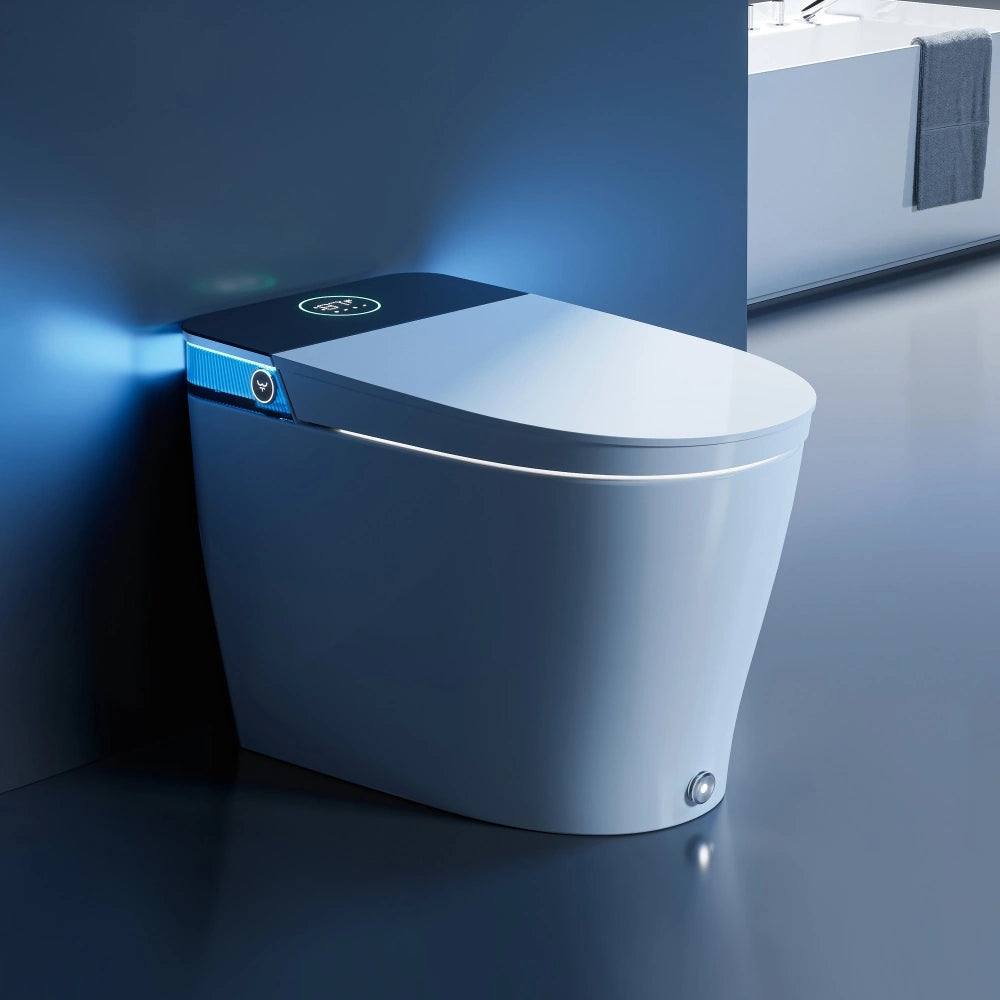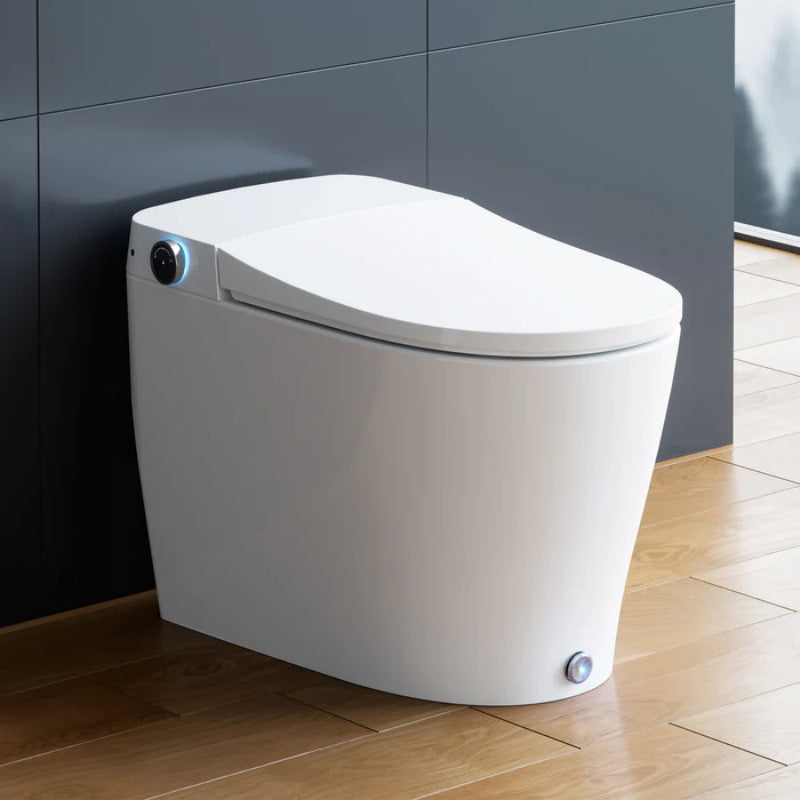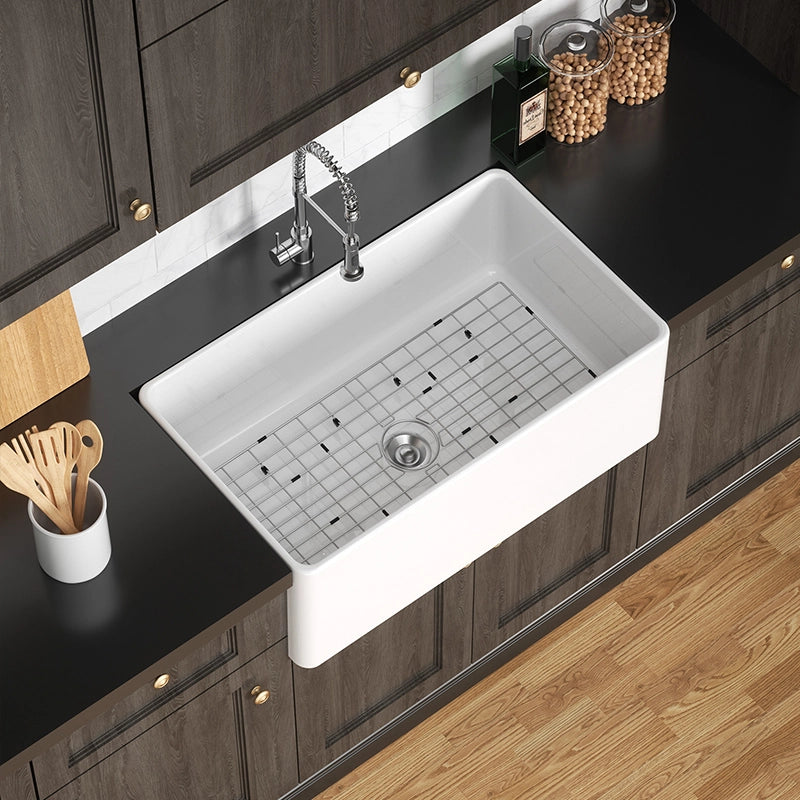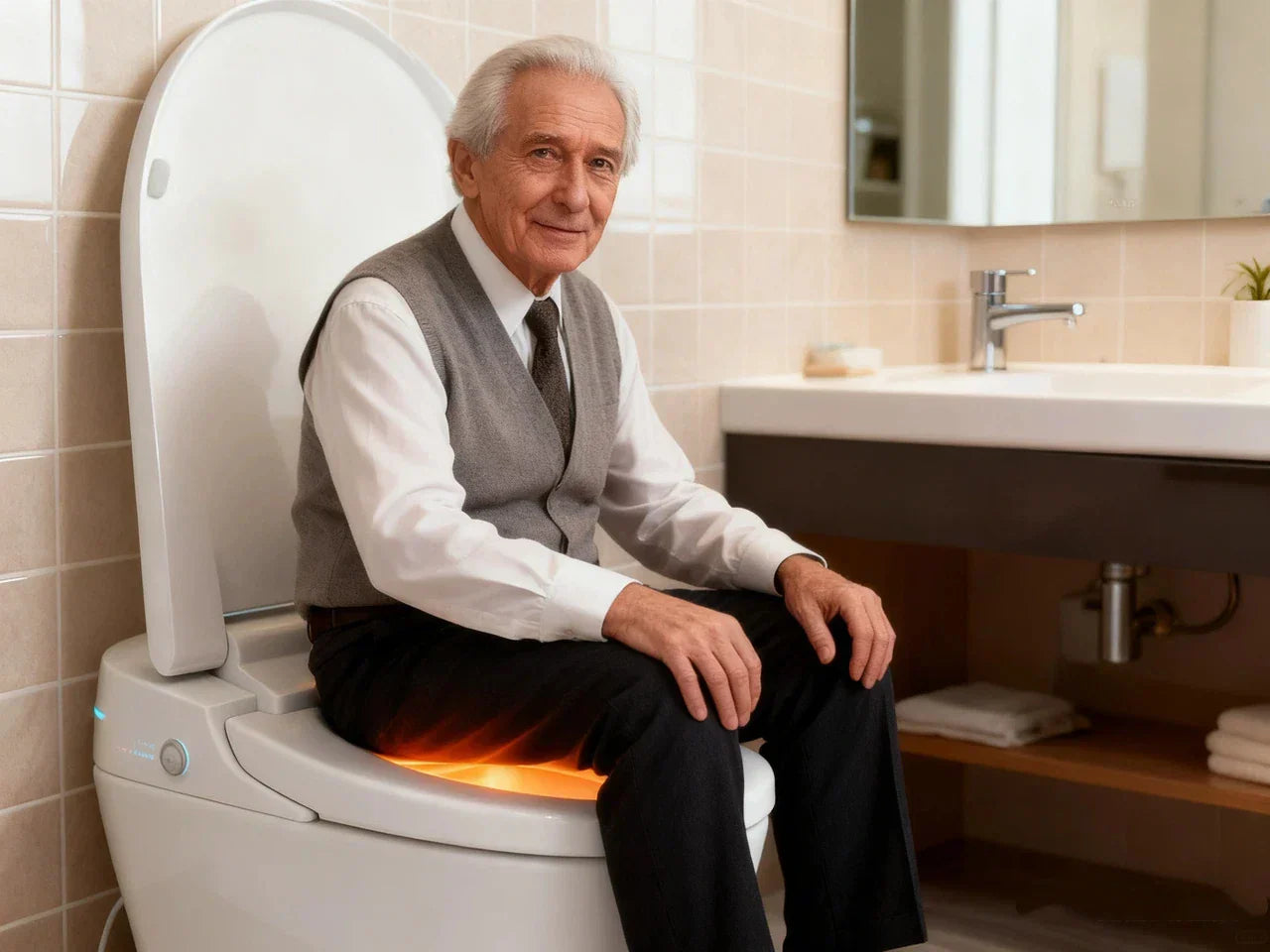A bidet with dryer delivers water cleaning and warm air drying in one hygienic, hands‑free routine. That means fewer wipes, less irritation, and a bathroom habit that feels clean without the hassle. In 2025, interest is surging because people want to cut toilet paper usage, improve skin comfort, and add simple, accessible upgrades at home. This guide gives you fast answers and clear guidance on dryer performance, safety, installation, costs, and long‑term savings. You’ll find a compact comparison matrix, a decision guide by needs and budget, and plain‑language FAQs from real‑world use.
Need a fast overview? Many modern bidet toilet seats now include a warm air dryer with adjustable temperature and time. If you’re choosing your first air drying bidet, planning a GFCI‑ready outlet, or trying to pick the fastest bidet with blow dryer, this reverse‑pyramid guide helps you decide right away—and then go deeper where you care most.
What Is a Bidet With Dryer? 2025 Context and Fast Facts
Before we dive into the detailed features and numbers, let’s set the stage: a bidet with a dryer isn’t just a fancy upgrade—it’s a modern bathroom essential for comfort, hygiene, and eco-friendliness. In 2025, more households are realizing that a gentle water wash followed by a warm air finish can replace traditional toilet paper, cut waste, and make every bathroom visit cleaner and more comfortable. Below, we break down what these devices are, why they matter this year, and the quick facts you should know before choosing one.
Definition, core benefits, and key features
A bidet with warm air dryer combines a gentle water spray with a built‑in dryer that blows warm air so you can finish without paper. It’s a compact unit that replaces your existing toilet seat. The most useful features today include:
-
Warm air dryer with adjustable heat and timer.
-
Adjustable wash pressure and temperature for a gentle, thorough clean.
-
Heated seat with even warmth and eco settings.
-
Deodorizer and air filter in many models.
-
Self‑cleaning stainless or antimicrobial nozzle.
-
Memory presets, smart remote or side‑panel controls, soft‑close lid.
-
Energy‑saving modes to cut idle power.
The core benefits are simple: less irritation, a cleaner feel, and a hands‑free finish that reduces the risk of bacterial transfer. Many users also like the comfort of a warm seat, especially in colder months.
Why 2025 matters: adoption and search trends
If 2020 made people rethink hygiene, 2025 is the year many act on it. Searches for “do bidets have dryers” and “bidet with dryer” keep climbing as more households upgrade from basic attachments to modern bidet seats with built‑in warm dryers. Urban and higher‑income buyers led early adoption, but the gap is closing as prices widen and installation stays simple. People are also responding to the environmental side: less paper, fewer clogged drains, and less wear on septic systems.
Fast facts and numbers to know
-
A typical user can save about 23 kg (around 50 lb) of toilet paper per year by switching to a bidet with warm air dryer. That translates to fewer trees cut and less manufacturing and transport impact over time.
-
Dryers are now common in mid‑range to premium electric bidet seats.
-
Deodorizers and nozzle self‑clean cycles are becoming standard in many models.
These numbers vary by household size and habits, but the pattern holds: air drying bidets can meaningfully cut paper use and waste.
Is a bidet dryer sanitary?
Yes, when used correctly. The hands‑free finish reduces rubbing and hand contact. Self‑cleaning nozzles rinse themselves before and after use, and filtered air helps keep the dryer output clean. As with any bathroom fixture, regular cleaning keeps things fresh and safe. Remember to wash hands after use, just as you would with any toilet routine.

Best Bidet With Dryer Picks (2025)
Choosing the best bidet with a dryer isn’t just about picking a brand—it’s about finding the right type for your needs. Some people want a fast, powerful warm air finish; others prioritize gentle drying or memory presets. In 2025, the focus is on matching features to lifestyle: luxury models for speed and comfort, mid-range for balanced performance, and entry-level seats for basic functionality without breaking the bank. Below, we break down the types, key drying criteria, and which models work best for different users.
Shortlist by type and why they stand out
Instead of focusing on brands, think in tiers and types. The right bidet seat depends on how fast you want to dry, how quiet you need it, and how much you value presets and comfort details.
-
Premium Japanese‑style seat: Strong, even airflow, fast warm‑air drying, deodorizer, rich temperature settings, and thoughtful accessibility features.
-
Premium Korean‑style seat: Powerful dryer, deep customization, great memory presets, and reliable eco modes.
-
Mid‑range electric seat: Excellent value with a capable warm air dryer, adjustable wash, heated seat, and a clear remote.
-
Entry electric seat: Core washing plus dryer at a lower price; may have fewer air temperature levels and slower drying times but still reduces paper use.
Each type “wins” for a different reason. Premium models offer luxury and speed; mid‑range seats offer the best balance of features and cost; entry models get you all the basics at a friendly price.
Dryer‑centric selection criteria
If drying performance matters most, focus on the following:
-
Drying time and airflow strength (look for higher airflow and efficient vent placement).
-
Number of temperature settings and top heat level (with safe limits).
-
Noise level in dB (quieter fans feel calmer for night use).
-
Energy use and energy‑saving modes (eco timers, seat occupancy sensors).
-
Seat heating consistency and contour comfort (affects how centered the warm air reaches you).
-
Extras: deodorizer, auto lid, night light, and clear remote labeling.
Use‑case picks by persona
-
Seniors or limited mobility: Choose a bidet with blow dryer that has strong airflow and a large, simple remote with raised icons. Auto open/close lids reduce bending. Memory presets save the right settings for daily use.
-
Sensitive skin or hemorrhoids: Pick gentle wash pressure, soft warm water, and a low‑heat dryer preset. Longer dry time on low heat can reduce irritation. A wider spray can also feel better.
-
Families and renters: Favor easy installation, child modes, clear lockout settings, and memory presets. If electrical outlets are limited, pick a unit with a longer power cord and flexible hose routing.
Compact side‑by‑side table (typical ranges)
Note: These are typical ranges across categories. Always check the exact specs for your chosen model.
| Category | Dryer Settings (Levels) | Approx. Dry Time | Noise (dB) | Energy Use (Dry) | Warranty (Years) |
|---|---|---|---|---|---|
| Entry electric seat | 2–3 | 2–4 minutes | 50–58 | 200–300 W | 1–2 |
| Mid‑range electric seat | 3–5 | 1.5–3 minutes | 48–55 | 250–350 W | 2–3 |
| Premium Japanese‑style seat | 4–5+ | 1–2 minutes | 45–52 | 250–400 W | 3–5 |
| Premium Korean‑style seat | 4–5+ | 1–2 minutes | 45–52 | 250–400 W | 3–5 |
Faster drying usually comes from better vent placement, stronger airflow, and smart temperature ramps rather than simply higher heat.
How Warm Air Dryers Work, Safety, and Performance
Before we get into the nuts and bolts, it helps to understand what’s happening when a warm air dryer is in action. In essence, these systems carefully move filtered air through a safe heating element and direct it exactly where you need it after washing. Safety sensors, temperature limits, and smart airflow design all work together to give you a hands-free, comfortable dry without risk.
Inside the system: airflow path and heating element
A bidet with warm air dryer uses a small fan to pull room air through a filter, past a safe heating element, and out through vents near the nozzle area. A seat sensor detects when you’re seated. After washing, the dryer starts on a timer with a set temperature and airflow. Some units shape the airflow for better coverage. Others use oscillating nozzles and slight seat tilts so the air reaches the right zone.
Key parts include:
-
Intake grille and air filter
-
Fan and motor
-
Heating element with thermal limits
-
Ducting and outlet vents
-
Seat occupancy sensor and temperature sensor
-
Control board and safety relays
Safety essentials and bathroom electrical
Modern seats include auto shutoff, thermal limiters, and anti‑scald caps on water and air. For power, use a nearby GFCI outlet. A GFCI helps prevent shock in wet areas by cutting power if it senses a fault. This is a standard best practice for bathroom fixtures and is widely recommended in U.S. electrical safety guidance.
If you need a new outlet, hire a licensed electrician to add a dedicated GFCI receptacle on a 120V/60Hz circuit (in North America). Keep cords tidy and away from water paths.
Settings that affect results
Your experience can vary based on small choices:
-
Air temperature level: Start medium; adjust up or down based on comfort.
-
Drying duration: Many seats default to 2 minutes. Add time if you prefer a complete dry without paper.
-
Seat position: Sitting slightly centered and still helps the airflow hit the right area.
-
Wash settings: Warmer water and a final gentle spray can shorten dry time.
-
Room conditions: Colder bathrooms may need a higher air temp or longer time.
Cutaway: what a “working diagram” would show
If you could see inside, a simple cutaway would label: intake grille and filter (back of seat), fan and heater core (under the shell), air duct running toward the bowl, angled outlet vents by the nozzle area, a seat sensor near the hinge, and a thermal fuse tied to the heater. These parts work together to control warm air, keep temperatures safe, and stop when you stand up.

Installation and Compatibility
Before jumping into the step-by-step installation, it’s important to know if the bidet seat will actually fit your toilet and what utilities you need.
Will it fit your toilet? Seat shapes and base clearances
Bidet seats come in round and elongated sizes. Most two‑piece toilets accept both types, while some one‑piece toilets (especially “French‑curve” designs) need special clearances. Measure between the tank and mounting bolt holes, check the distance to the rim, and confirm your bowl shape. If your toilet has a very curved tank front, look for seats that list that shape as compatible.
Electrical and water requirements
You will need:
-
A nearby GFCI 120V/60Hz outlet (North America). Check cord length (often around 4 ft).
-
A cold water feed at the toilet’s fill valve.
-
A T‑valve to split water between the tank and the bidet.
-
Basic tools: adjustable wrench, screwdriver, and plumber’s tape.
The initial investment in a bidet includes the seat and, if needed, electrician work for the outlet. Many homes already have a GFCI within reach; if not, budget for a new outlet near the toilet.
DIY install steps and time estimate
Most installs take 30–60 minutes. Here is the simple flow:
- Turn off the water supply and flush to empty the tank.
- Remove the old seat and clean the porcelain.
- Attach the mounting plate using the existing bolt holes.
- Connect the T‑valve to the toilet’s fill valve; attach hoses to the tank and to the bidet seat.
- Slide the bidet onto the mounting plate until it clicks.
- Turn on the water and check for leaks.
- Plug into a GFCI outlet and run a quick self‑clean cycle.
Tip: Keep hoses untwisted and hand‑tighten first. Finish with a quarter‑turn using a wrench—just enough to seal without damage.
Do I need a GFCI outlet for a bidet seat?
Yes. Bathroom outlets should be GFCI protected to cut power in a fault. This helps prevent shock in wet spaces. If you do not have a GFCI within reach of the toilet, have one installed by a licensed electrician.
Accessibility, Hygiene, and Health Benefits
Beyond convenience, bidets with dryers offer meaningful accessibility, hygiene, and health benefits. They make bathroom routines easier for people with limited mobility, reduce irritation for sensitive skin, and support cleaner, more hygienic outcomes.
Independence and dignity for limited mobility
A bidet with dryer helps people who find twisting, reaching, or wiping hard. The hands‑free wash and warm air dry reduce strain and improve daily comfort. Large remotes, presets, and auto lid features help people stay independent at home.
Skin health and comfort
Rubbing with dry paper can cause irritation, especially for people with hemorrhoids, eczema, or sensitive skin. A gentle water clean followed by low‑to‑medium air heat is kinder to the skin. Users often report less soreness and a “fresh” feel without lotions or wipes.
Cleaner outcomes, fewer germs
Water first, then air—that simple process reduces hand contact and helps keep things hygienic. You still wash your hands after using the bathroom, but the routine is cleaner with less rubbing, based on recommendations from the Centers for Disease Control and Prevention. The bidet also keeps mess off paper and reduces smearing, which supports better personal hygiene.
Are bidet dryers safe for sensitive skin?
Yes, with the right settings. Start on low heat and shorter sessions. If you have reduced sensation (neuropathy) or a skin condition, avoid high heat. It’s fine to finish with a brief pat using a soft, low‑lint towel on sensitive days.

Cost, Savings, and Sustainability
Looking beyond the initial purchase, a bidet with dryer can make sense financially and environmentally. From energy use and water savings to reducing toilet paper waste, these seats offer measurable savings over time while supporting sustainability.
Total cost of ownership
Think about the full picture:
-
Seat cost: Ranges from entry to premium depending on features.
-
Electricity: The dryer uses about 200–400 watts while running; the heated seat and water use less when idle, especially with energy‑saving modes.
-
Water: A wash uses less water than it takes to make a few sheets of paper. The net environmental impact is still favorable for bidets in most homes.
-
Maintenance: Replace small filters when needed and clean parts monthly. These costs are low.
Paper savings and environmental impact
Cutting paper is the big win. A single bidet with warm air dryer can reduce paper by around 23 kg (about 50 lb) per person per year. That means fewer trips to buy bulk packs, less strain on plumbing, and a positive impact on waste. For septic users, less paper helps the tank remain healthier longer between pumps.
How much electricity does a bidet dryer use?
Use this simple estimate:
-
Find the dryer wattage on the spec sheet (many are 250–350W).
-
Multiply by your average dry time. For example, 300 watts × 2 minutes = 600 watt‑minutes per use, or 0.01 kWh.
-
Multiply by uses per year. At two uses per day, that is 0.01 kWh × 730 ≈ 7.3 kWh per year for drying alone.
-
Add a few kWh for the heated seat, depending on your eco settings.
Even with daily use, the electricity cost is often a few dollars per year, especially if you use eco modes.
Savings calculator (quick method)
Follow these steps to estimate your 1/3/5‑year savings:
- Enter your current paper use per person (rolls/month) and cost per roll.
- Estimate reduced use with a bidet with dryer (many users cut 75–100%).
- Estimate bidet electricity: dryer kWh + seat standby (often 10–40 kWh/year with eco settings).
- Multiply costs: paper saved minus electricity cost per year.
- Subtract the initial investment in a bidet to see payback.
Sample scenario (per person):
-
Before: 8 rolls/month at $1/roll = $96/year.
-
After: 1 roll/month for a final pat = $12/year.
-
Electricity for dryer + seat: ≈ $5/year (varies by rates).
-
Net paper savings: $84/year – $5 = $79/year saved.
-
If the seat costs $350, simple payback is a little over 4 years, faster with multi‑person households.
Actual results depend on your prices and habits, but the math is easy to run with your numbers.
Maintenance, Troubleshooting, and Upgrades
Keeping your bidet with dryer in top shape is easier than it sounds. Routine cleaning, simple checks, and occasional adjustments ensure long life, consistent drying, and peak hygiene.
Routine care for long life
A few simple habits keep your bidet fresh and working well:
-
Wipe the seat and lid weekly with a soft cloth and mild soap.
-
Clean the nozzle using the self‑clean cycle; wipe gently if your model allows manual access.
-
Rinse or replace the air filter and deodorizer cartridge as scheduled.
-
Descale if you have hard water (check your manual).
-
Keep vents clear. Dust can block airflow and slow the dryer.

Fix common dryer issues
-
Weak airflow: Check and clean the air filter. Confirm outlet vents are not blocked by the bowl or your sitting position.
-
No heat: Verify temperature settings are not on eco or low. Some units have a safety reset after a thermal event; unplug for 1–2 minutes and try again.
-
Inconsistent temps: Turn off eco mode during use. Cold bathrooms may need a higher air level or longer time.
Optimizing dryer performance
-
Sit centered and still for the first minute. Small changes in position help the air reach the right spot.
-
Try medium temperature for comfort; increase time before increasing heat.
-
For the fastest finish, use a gentle warm wash, wait a moment for drip‑off, then dry for 1–2 minutes. If you like a perfectly bone‑dry finish, add 30–60 seconds.
-
If you prefer zero paper, keep a small, soft towel nearby as a backup for rare days. A single pat is often enough.
Troubleshooting flow (quick path)
-
Does the fan run? If no: check seat sensor (must be seated), power, and GFCI.
-
Fan runs but no heat? Check temperature settings, eco mode, and try a reset.
-
Heat works but still damp? Increase time, adjust position, clean filter/vents, raise air level one step.
-
Still slow? Room is cold or airflow is blocked; improve bathroom warmth or consider a model with higher airflow.
Decision Guide
Choosing the right bidet with dryer means matching features to your priorities—speed, noise, energy use, accessibility, and budget all matter. This section breaks down the options by category, highlights which seats excel in which areas, and helps you make an informed decision based on your lifestyle and preferences.
Comparison matrix (by category and dryer focus)
| Priority | Entry Electric Seat | Mid‑Range Electric Seat | Premium Japanese‑Style Seat | Premium Korean‑Style Seat |
| Drying speed | Moderate | Good | Very fast | Very fast |
| Dryer heat levels | 2–3 | 3–5 | 4–5+ | 4–5+ |
| Noise at night | Moderate | Moderate to quiet | Quiet | Quiet |
| Energy‑saving options | Basic timer | Eco schedules, seat sensor | Advanced eco modes and sensors | Advanced eco modes and sensors |
| Accessibility | Basic controls | Clear remote, presets | Large remote, auto lid (select) | Large remote, presets, child mode |
| Price vs. features | Best for tight budgets | Best balance | Best experience | Best experience |
Use this table to match your needs. If you want the quickest dry, target premium seats. If you want the best mix of features for the money, mid‑range is hard to beat.
Decision guide by priorities
-
Fastest dry: Choose premium units with higher airflow, multiple heat levels, and smart vent placement.
-
Quiet operation: Look for seats that list low dB ratings and “quiet fan” in specs; foam dampening helps.
-
Energy saver: Seats with occupancy sensors and true power‑down eco modes help cut standby draw.
-
Best for seniors: Large, simple remotes; clear icons; auto open/close lid; stronger dryer; reliable memory presets.
-
Renter‑friendly: Standard mounting plate, flexible hose routing, and no special plumbing. Pick models that work with common two‑piece toilets.
Do bidet dryers replace toilet paper completely?
For many people, yes. With a good bidet with dryer, an extra 30–60 seconds often gets you fully dry. Some users still prefer a brief final pat. You can choose based on comfort and time.

Quick Tips for First‑Time Users
-
Start with lower heat and work up if you need it.
-
Sit centered for better airflow.
-
Try presets so everyone in the home gets their ideal wash and dry.
-
Use energy‑saving modes at night or while away to cut standby power.
-
Clean filters and vents monthly; a clean dryer is a faster dryer.
Final Takeaways
A bidet with warm air dryer can make daily life easier, cleaner, and more comfortable for a wide range of users. If speed matters, target premium units with strong airflow and smart venting. If value matters, mid‑range models strike a strong balance. For seniors and those with limited mobility, the hands‑free wash and dry restore independence and reduce strain. The benefit is clear: less paper, less irritation, and a routine that feels luxurious without being fussy.
Ready to choose? Match your priorities to the decision guide above, confirm your toilet shape and outlet location, and plan a simple 30–60 minute install. With the right seat and settings, your bathroom will feel new—and your daily routine will feel clean, gentle, and easy to maintain.
FAQs
1. Is a bidet with a dryer worth it?
Yes—definitely! A bidet with a dryer gives you that fresh, clean feeling without relying heavily on toilet paper, which can save money and be gentler on your plumbing. For multi‑person households, it’s a real comfort upgrade—you don’t have to worry about paper shortages, and everyone can enjoy a warm, hands‑free drying experience. Some people even say it feels spa-like compared to the usual routine.
2. How do you dry after a bidet?
It’s pretty simple. Most bidets with dryers let you press the “dry” button, and you can start with medium heat for around 1–2 minutes. After that, you can tweak the time a bit if you want a bit more warmth, or just do a quick pat with toilet paper if you feel like it. It’s all about adjusting to what feels comfortable for you—some like it longer, some just need a short blast.
3. Do bidets have air dryers?
Many electric bidet seats come with built-in air dryers, especially mid-range and premium models. Basic attachments or non-electric bidets usually don’t include a dryer, so you’d still need toilet paper or a towel. If you want that hands-free drying, make sure the model specifically lists a “warm air dryer” feature.
4. Will a bidet dryer irritate my skin?
It can if you crank up the heat too high or dry for too long. Start with low heat and a short drying time to see how your skin reacts. You can gradually increase both if you want a warmer, more thorough dry. Most people find that even at medium heat, it’s gentle enough for daily use.
5. Do I need a GFCI outlet?
Yes, definitely. Bathrooms are wet environments, and a GFCI outlet protects you from electrical shocks. Almost all modern bidets with dryers require a nearby GFCI outlet to operate safely, so it’s both a safety requirement and a convenience—you don’t have to worry about any accidents.
References








Leave a comment
This site is protected by hCaptcha and the hCaptcha Privacy Policy and Terms of Service apply.